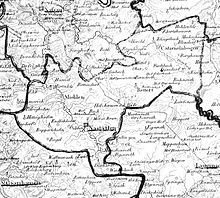Office of Naststätten
The Office Nastätten based in Nastätten was from 1775 to an Administration- and judicial district in the country under the rule of Hesse-Kassel standing low Katzenelnbogen and from 1817 to 1866 is one of 28 offices in the Duchy of Nassau . In the Nassau time of the Office as a local governor of the Duke stood at the head bailiff .
history
Nassau
The following 35 localities belonged to the Nastätten office:
- the places Naststätten , Berndroth , Bogel , Buch , Diethardt , Himmighofen , Holzhausen an der Haide , Kasdorf , Münchenroth , Oelsberg , Pissighofen , Reckenroth , Ruppertshofen , Weidenbach, formerly belonging to the Niedergrafschaft Katzenelnbogen .
- formerly Vierherrischen and then belonging to the low-Katzenelnbogen places Bettendorf , Ergeshausen , Herold and Obertiefenbach .
- the formerly quadrilateral and then jointly Nassau-Usingenschen and Nassau-Oranischen places Berg , Ehr , Hunzel , Marienfels .
- the Nassau-Usingen towns of Berghausen , Dörsdorf , Eisighofen , Mudershausen .
- up to the 1778 Zweiherrischen and then Nassau Because Freiburgische places Endlichhofen , Miehlen , Rettert .
- the former Hessen-Darmstadt towns of Allendorf , Ebertshausen , Katzenelnbogen , Klingelbach , Mittelfischbach , Oberfischbach .
In 1820 the office consisted of 31 parish districts, including a town, 2 spots, 32 villages and 61 farms and mills. 2,308 families or 9,119 residents lived in the office. Of these, 8,041 were Protestant, 903 Catholic, 4 Mennonites and 117 Jews.
After the March Revolution in 1848, the administration was reorganized. By law of April 4, 1849, administration and jurisdiction were separated at a lower level in Nassau. The reform came into effect on July 1, 1849. 10 district offices were established for administration , the offices continued as judicial offices (i.e. courts of first instance). The administrative tasks of the Naststätten office were carried out by the Langen-Schwalbach district office , the jurisdiction of the Naststätten justice office. However, the reform was reversed on October 1, 1854, the districts abolished and the previous offices restored.
Prussia
After the Prussian annexation of the duchy when the new province of Hesse-Nassau was divided into districts on February 22, 1867, the office of Nastätten became part of the Unterlahnkreis in the Wiesbaden district .
Only as part of this reorganization will administration and jurisdiction be separated. The judicial officials in the offices were initially responsible for the jurisdiction in the first instance, which was previously carried out by the office, and the Runkel district court was formed on September 1, 1867 . But even after the founding of the district, the previous office structure will be retained. The Royal Ordinance of February 22, 1867 regulated: "The administrative districts as narrower administrative districts exist in their previous limits" The former offices form the three districts of the district. According to § 13 of the district constitution, the districts sent the former offices six representatives to the new district council . The bailiff was in charge of the local police and the district administrator. When the new district order of the Hesse-Nassau province came into force on April 1, 1886, the western part of the office around Nastätten was assigned to the newly created Sankt Goarshausen district , while the eastern part around Katzenelnbogen remained with the reduced Unterlahnkreis.
With the administrative reform of 1885/1886 the offices were finally dissolved.
Bailiffs
- 1816: Johann Peter Schilling
- 1816–1822: Georg Christian Sandberger
- 1822–1823: Christoph Flach
- 1823–1836: Philipp Wilhelm Volk
- 1836–1839: Johann Friedrich Halbey
- 1839–1840: Karl Eyring
- 1840–1842: Carl August Sell
- 1842–1849: Friedrich Philipp Müller
- 1854–1868: Martin Friedrich Schenck
- (1868) 1869–1874: Julius Adolph Schreiber
- 1874–1877: vacancy
- 1877–1883: Friedrich Ludwig Riesch
- 1885–1886: Wilhelm (Willy) Friedrich Christian Adolph von Motz
literature
- Thomas Klein: Volume 11: Hessen-Nassau, the series: Walther Hubatsch: Outline of German administrative history 1815-1945, 1979, ISBN 3-87969-126-6 , pp. 170-172
Individual evidence
- ↑ Annals of the Association for Nassau Antiquity and Historical Research : Volume 10, 1870, p. 331 ( online )
- ↑ Law of April 4, 1849 (VBl p. 87); Law, the execution of the law on the separation of the administration of justice from the administration in the lower instance on May 31, 1849, (VBl p. 409)
- ↑ Law of July 24, 1854 (Bvl. P. 160)
- ^ Intelligence Gazette for Nassau of March 11, 1867, Royal Decree, page 111 ( online )
- ↑ VO of June 26, 1867, GS p. 1094
- ↑ Royal Decree of February 22, 1867 Supplement to the intelligence paper for Nassau of March 11, 1867, § 8 and 9
- ↑ GS 1885, p. 229

